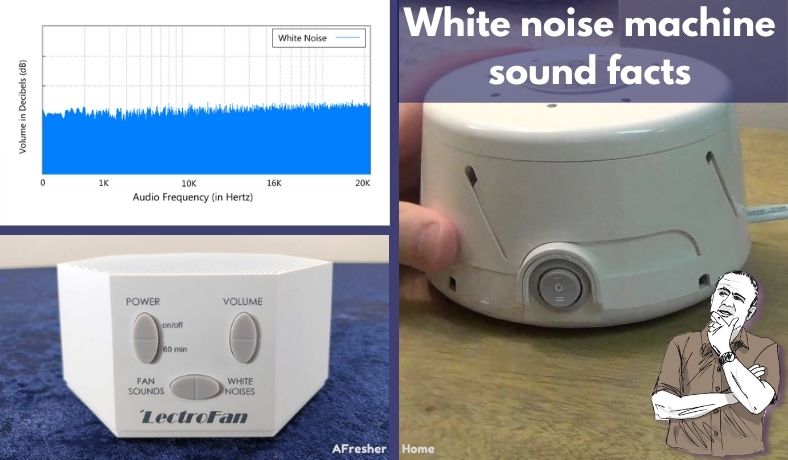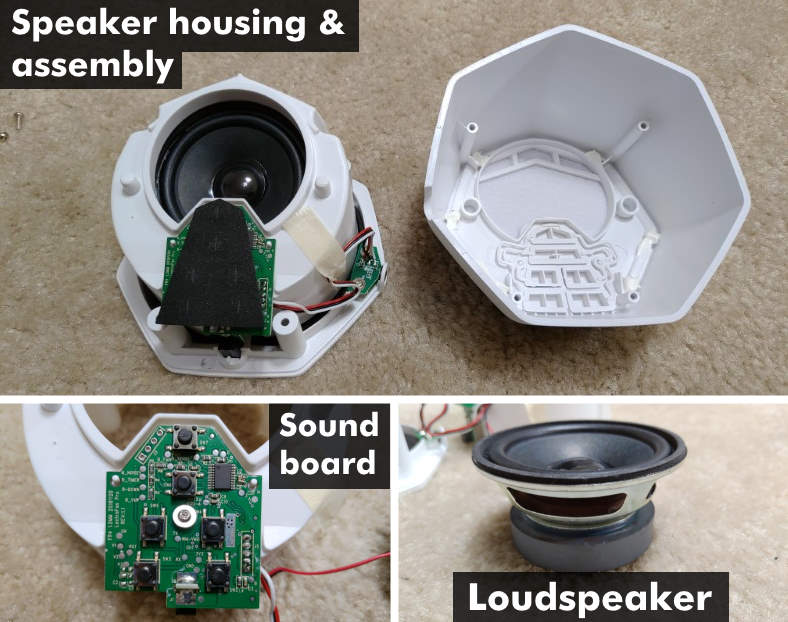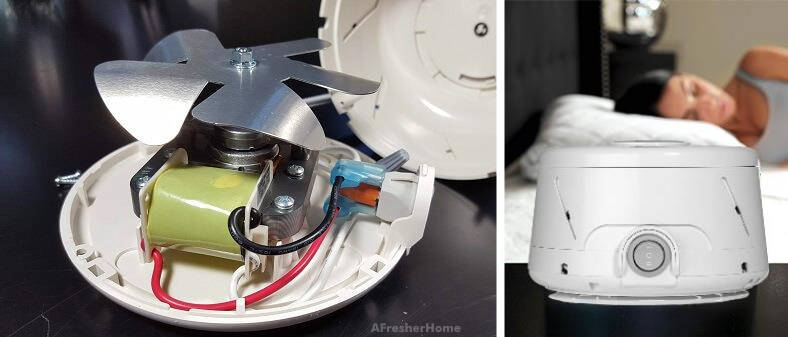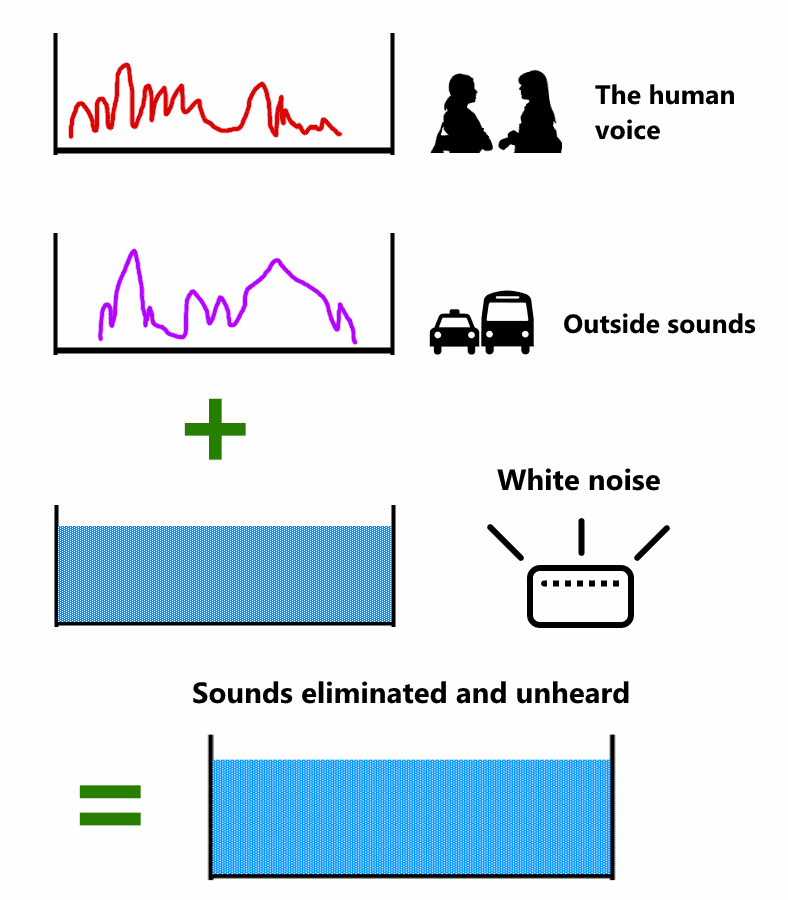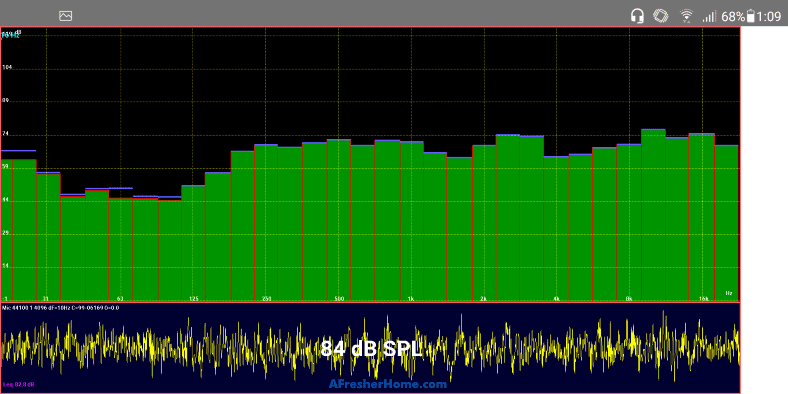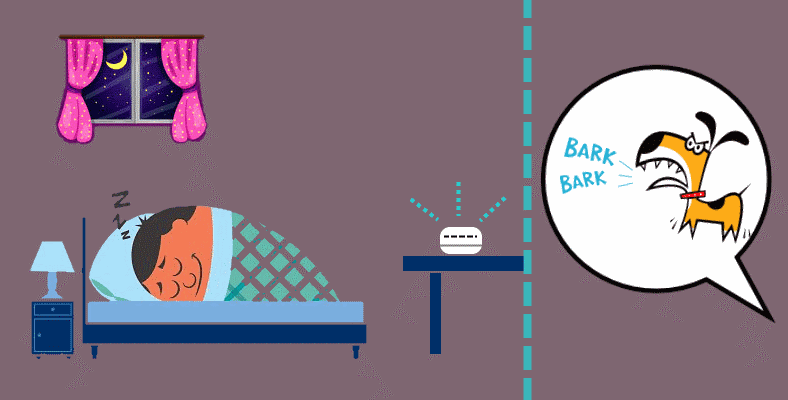White noise can really help your quality of life in a lot of ways: privacy, better rest or sleep, studying, and even more. But what does a white noise machine sound like?
Great news! I’ll let you hear for yourself!
In this article I’ll share:
- Real sounds from a popular white noise machine.
- What they are exactly, how they work, and the different types.
- Other helpful facts to know.
Contents
What does a white noise machine sound like? (Video sound samples)
What better way to find out what a white noise machine sounds like besides listening to real white noise machine sounds? To help you hear for yourself, I’ve provided two videos below with sound samples from a popular model called the LectroFan (Classic). It’s a good representative of many electronic white noise machines.
Like other brands or models, the LectroFan provides both nature sounds and a variety of white noise options to pick from. These are:
- 10 white noise sound styles.
- 10 fan sounds (box fan, attic fan, oscillating fan, etc).
LectroFan demonstration video #1: Noise sounds
In this video, I start with the default (first) sound, brown noise. I then go through the other 9 sounds and loop back to the 1st one again by using the noise sound button to show you how it works.
You can hear the short “whoop” sound after the 10th noise sound is played. That’s an indicator to let you know it’s starting back over at sound #1.
LectroFan demonstration video #2: Fan sounds
In this recording, you’ll hear all 10 simulated electric fan sounds the unit provides. I start with the first (large fan) and go through the remaining additional 9 sounds before returning back to the first.
Here’s a list of the sounds in case you’re interested:
| # | Fan sounds | Noises |
|---|---|---|
| 1 | Large fan | Brown |
| 2 | Industrial fan | Chestnut |
| 3 | Mellow fan-low | Cinnamon |
| 4 | Mellow fan-high | Tan |
| 5 | Exhaust fan | Amber |
| 6 | Attic fan | Cream |
| 7 | Circular fan | Pink |
| 8 | Vent fan | Coral |
| 9 | Box fan | Champagne |
| 10 | Oscillating fan | Pure white |
What is a white noise machine exactly? How does a white noise machine work?
Simply put, white noise machines are devices designed to mask, or cover up, sounds we would otherwise hear. They generate “white noise” patterns (a general name, sometimes used incorrectly) to make this possible.
If the volume of the sound you want to block is equal to or less than the volume of the white noise, you’ll be prevented from hearing them. This makes it possible to read or study better, sleep better, concentrate on relaxing, or to keep your privacy in an office setting or bathroom.
These are just some examples of the most common uses for them.
White noise machine uses
Sound machines are used for a wide range of circumstances to block sounds, avoid distractions, and create a soothing and distraction-free environment.
Some of the most helpful white noise machine uses are:
- In businesses (cubicle or office privacy)
- Study rooms
- Therapist offices
- Helping babies sleep
- Stress relief or meditation
- Blocking outdoor noise at work
- Improving your mood
- Increasing focus & concentration
- For improving productivity & work quality
- Bathroom privacy & a relaxing restroom environment
- For travel (ex.: in hotel rooms)
How do white noise machines work?
White noise machines (also called sound or sleep machines sometimes) come in two types based on how they work:
- Electronic (digital sound) models.
- Electromechanical models.
Both do the same thing generally but have some big differences in how they go about as you’ll see.
1. Electronic models
Electronic models use integrated circuit chips (ICs) to create noise patterns either generated as a continuous pattern or stored as an audio file much like .MP3 music. Predetermined sounds are generated and adjustable volume control is standard.
Some models have more options than others, offering special audio sounds like those of nature and rain, electric fans, and other versions of white noise to best suit your taste.
2. Electromechanical
This type uses an older type of noise-generating technology. They’re simpler to use, too. Although less popular now they’re still widely used and a good choice for many people.
Electromechanical white noise machines use an electric motor to spin a small fan creating a constant soft airflow that moves through the small vents, producing a soft tone. Some allow for volume and some sound tone adjustment as well, although they’re not anywhere as near as versatile as electronic models.
On the other hand, while they don’t have the options that solid-state models do, they’re super easy to use and still preferred by some people because of their sound.
How white noise blocks sound
White noise machines help by creating a range of sounds that “mask”, or cover up, distracting sounds you normally can hear.
White noise machines produce a fairly wide range of sound frequencies that spreads across the range of many common sounds that bother us. As long as the volume of any inside or outside sound is equal to or less than the volume of noise made by the machine it can be effectively blocked and go unnoticed.
With a few exceptions, nearly all nearby sounds with low or moderate volume – traffic, conversations, coworkers – all the frequencies that we can hear can be blocked.
Sound is mostly about your brain
Our brains can’t process a lot of audio information at once. Ever been in a situation where everyone’s talking at the same time? It’s almost impossible to pick out any one person speaking because it’s all mixed together.
That’s the idea behind sound machines & white noise: The audio frequencies we hear are masked by white noise and we don’t hear it. Whether it’s dogs barking, the radio or TV, or your neighbor’s conversation in a nearby apartment, it all works the same way.
Because our brains can’t separate sounds that arrive at our ears mixed together, it’s as if we never heard them. Sounds masked by white noise are essentially blocked and disappear since we can’t tell they’re there anymore.
What is white noise? What are pink and brown noise?
Shown: white noise vs pink noise vs brown noise. Each noise “color” has a particular characteristic based on the amplitude of the frequencies that make it up over the range of human hearing.
In the science and audio world, some types of useful and commonly used sound patterns are referred to by a name that’s a color. White noise, pink noise, and brown noise are some of the most common in fact.
- White noise is a sound pattern with a flat frequency response if you plot it on a graph. In other words, the signal doesn’t drop in volume over the sound frequency range. This is, by definition, the real meaning of white noise although for the everyday person “white noise” is frequently used to describe some generic noise sound pattern like from a box fan or other devices. Since it has full amplitude (volume, in dB) at the upper range, true white noise can sound harsh in some cases, unlike brown noise.
- Pink noise is different from white noise in that starting at the bottom, pink noise decreases in amplitude by about 3dB per octave (an octave is a double or halving of a sound frequency & commonly used in sound measurements). Pink noise, because of how human hearing works, actually sounds about even to us even though technically it’s not. Pink noise is often used for sound system measurements, set up, and other audio engineering purposes.
- Brown noise could be called “softer” in some ways. Sort of like pink noise, as the sound frequency/octave increases up the scale their amplitude falls, but in this case even more: 6dB per octave. If you listen to a brown noise test track it will sound less “harsh” as the upper frequencies that our ears are more sensitive to are lower in volume. In reality, many things like electric fans or white noise machines often create a sound that is much closer to brown noise than white noise.
An example of the “white noise” a sound machine creates
Using a test microphone and a real-time analyzer (RTA), I measured the frequency sound response output of a white noise machine set to its “white noise” option. As you can see, it’s not a perfectly flat output and isn’t technically white noise in fact.
In the audio spectrum analyzer snapshot I’ve provided above you can see an example of some things I’ve mentioned. Above, it’s easy to see that this white noise machine, when set to its “white noise” option, isn’t actually real white noise. It’s somewhat close, but when listening to one in real life you’ll notice the higher frequencies are a bit “soft” and muted.
One reason for this is that digital white noise machines use a signal speaker with a limited sound performance range. Also, the goal isn’t to create real white noise – it’s to create a broad pattern of sound that can mask the range of sound our ears can hear. In that respect they can work pretty well!
Likewise, non-digital (electromechanical) models naturally have a sound “roll off” due to how they work, such as how the sound pattern produced by a fan and electric motor doesn’t have harsh upper-end output.
How loud should a white noise machine be?
The volume you need for a white noise machine depends on the volume of the sound you’re wanting to block out. It’s important to shop carefully as while some models have a fairly good amount of volume you can use (say around 100dB or so, which is fairly good) others can be a very different story!
Generally speaking, I recommend at least 80dB volume available but more is definitely better. Ideally, you’ll never need more than some average listening level like 60dB-70dB, but it’s important sometimes to have more on tap.
Here’s another important thing to know: not all manufacturers specify the volume a white noise machine is capable of. In that case it’s helpful to know:
- Electromechanical units are often fair to fairly good for volume but often don’t offer high volume output.
- Brand names offer better performance in this area and more volume steps (more volume up/down steps you can use).
- Budget models are usually fine for average noise levels, for rest or study, but in very noisy areas probably aren’t a good bet.
Before spending the money I’d recommend carefully checking buyer reviews in case you find complaints about insufficient volume. It’s not a typical problem for most people but if you have ever lived near someone yelling, playing loud music, or some such bother you know how bad it can be!
